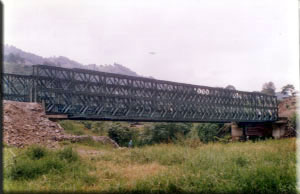|
Particularly developed for remote regions and
circumstances where recources and transport facilities are limited,
the PSB system bridge has increasingly proved to be an ideal
solution for opening up developing countries. Developed by
experienced engineers, the bridge is pragmatic in design, requiring
only a limited number of components. The components required can be
carried by light vehicles and can be handled manually. Complete
erection by hand, without the availability of crane(s), is an
important feature of the PSB-bridge.PSB components enable bridges to
be built with a free span of up to 56 metres without any need for
supports. This length can be multiplied by using piers. The use of a
limited number of different components and serial production have
resulted in a construction with a favourable price/-performance
ratio.The deck can be manufactured from locally available materials
such as wood or concrete. In the standard version the deck is
finished with steel panels.The external appearance, combined with
the high quality durable construction, makes PSB bridges the
solution for permanent applications.In spite of the simple
construction, PSB bridges are capable of coping with high demands.
The bridge is composed of girders which are made up of standard
components held together by bolts, steel cross-girders and deck
components.The use of high grade steel results in a low dead weight
combined with maximum strenght. Bridge parts are assembled using
HSTC-bolts. Welding has been kept to a minimum in low-critical areas
resulting in high fatigue life.All components are designed and
manufactured to exact tolerances and are hot-dip galvanised. The
modular length (ML) of the bridgesystem is 4000 mm, but on request
ML is also available in 10 feet and 12.5 feet.
|
|
Why to build bridges
If a country is to develop and make full use of its natural
resources, it is imperative that a good internal communication
system is available, a system which allows the development of
natural resources in the most effective and economic way in order to
supply markets with manufactured goods and distribute food over
large areas. Good communications are vital for deployment of the
forces of law and justice in remote areas, resulting in stable
economic areas and markets. Each nation has the duty to govern
itself in such way that prosperity and security is attained and an
extensive and well-built internal road system will achieve those
aims.Each country has its own peculiar problems, either
geographically or climatically, which may prevent the efficient
construction of these roads and bridges. Shortages of labour or
skills may contribute to these problems, together with the inability
to transport building materials to where they are needed. However,
once these problems have been recognised, the obvious solution is
the erection of bridges to open up the country for road building and
the development of the natural resources.
|
|
The Portable Steel Bridge
The erection of bridges may in itself present a problem were it not
for the fact that the PSB has been designed and manufactured
precisely for this reason. Bridges must be able to be transported by
light vehicles to the building site and be erected by hand by
unskilled labour. The bridge must carry whatever load is required -trucks,
cars, pipelines, cables and people- at the least expense. The bridge
must also serve for the purpose of permanent and semi-permanent use
with a minimum of maintenance, to stay there for as long as it is
needed.The concept of the PSB with its sophisticated design allows
bridges to be built under extreme conditions, whether in remote
mountainous areas, in rain forests or in sub-arctic regions. The PSB
has been designed to allow for these conditions, making it suitable
for erection wherever a bridge is needed.The low weight of its
components, transportation by light vehicles and the limited number
of components make building and erection by non-skilled labour a
particularly useful feature of the PSB. However, on-site training by
an engineer conversant with the system will accelerate
construction.The use of high tensile steels and HSTC-bolts means
that the bridges can be erected in simple and light configurations,
still allowing high permissible loads and traffic cycles. The
components are simply bolted together and more steel components are
bolted on in those areas where greater stress and loads will be
experienced. Therefore, only the correct number of components is
used for any particular bridge without wastage and cost
overruns.Although the whole structure may weigh hundreds of tons,
each component is light enough to be manhandled and bolted on. Spans
of considerable length have been erected by unskilled labour in the
minimum of time.
|
|
Launching the bridge
Usually the bridge is erected by launching it across
using the cantilever method. The bridge is built on rollers with a
temporary skeleton structure (launching nose) on the front of the
bridge which is pushed across. The launching nose is then dismantled
and the bridge lowered onto its bearings.Once in situ, the bridge
needs little maintenance because of its extensive galvanising and
only regular checks on bolts are required because of the likelihood
of removal or theft. In addition, because of the minimum number of
welded parts, the occurrence of cracks together with fatigue can be
disregarded.Many PSBs today are used by local authorities, forestry
commissions, and mining and drilling companies. The achieved
improvements in the infrastructure have immediate beneficial effects
on the economy of the country at large as well as on the local
population. Transportation of goods and access to medical and
educational facilities greatly enhances the livelihood of those
living in remote and inaccessible areas, creating jobs and
opportunities.
|
|




![]()


